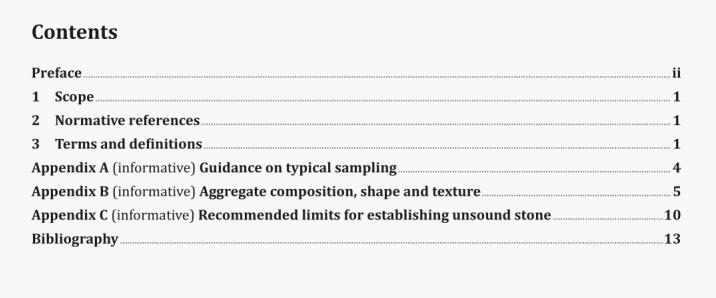Glossary and general series information
AS 2758.0-2020 pdf download.Aggregates and rock for engIneering purposes
Part 0 : Glossary and general series information.
2 Normative references
There are no normative references in this document.
NOTE Documents referenced for Informative purposes are listed In the Bibliography.
3 Terms and defInitions
For the purposes of this series, the following terms and definitions apply.
aggregate
granular material produced from crushed rock, gravel, sand, metallurgical slag or reclaimed material, used in in civil construction products and engineering works
3.1.1
coarse aggregate
aggregate in which the majority of particles are retained on a 4.75 mm AS sieve
3.1.2
fine aggregate
aggregate, formed naturally in sand deposits or purpose-made by crushing and processing, in which the majority of particles pass a 4.75 mm AS sieve
Note I to entry: Purpose-made aggregate is known as manufactured sand.
3.1.3
graded aggregate
aggregate in which more than 15 % (by mass) of the total material is retained on at least each of three consecutive sieve sizes in a set
Note I to entry: The typical sieve set used in Australia includes sieves with the following aperture sizes: 75.0
mm, 53.0 mm, 37.5 mm, 26.5 mm, 19.0 mm, 13.2 mm, 9.50 mm, 6.70 mm, 4.75 mm, 2.36 mm, 0.600 mm and 0.075
mm. This selection of sieves is approximately a quarter series.
Note 2 to entry: Crushed rock that consists of a mixture of line and coarse aggregates, the coarse fraction being graded, is considered a graded aggregate for the purpose of the AS 1141 series.
3.1.4
recycled aggregate
aggregate derived from the processing of materials previously used in a product or from construction activities that would otherwise be sent to waste
Note 1 to entry: Where recycled aggregates are to be used In construction, they should be subject to a separate works specification under the AS 2758 series.
3.1.5
single sized aggregate one sized aggregate
aggregate in which at least 60% (by mass) of the total material passes a sieve, which is immediately less than the nominal size of the aggregate and is retained on the sieve immediately following the selected sieve in the selected set
Note I to entry: The typical sieve set used in Australia include sieves with the following aperture sizes: 75.0 mm, 53.0 mm, 37.5 mm. 26.5 mm, 19.0 mm, 13.2 mm, 9.50 mm, 6.70 mm. 4.75 mm, 2.36 mm, 0.600 mm and 0.075 mm. This selection of sieves is approximately a quarter series.
3.2
may
indicates the existence of an option
3.3
nominal size
designation of an aggregate that indicates the largest size particle present
Note 1 to entry: The concept of nominal size of an aggregate is for convenience of reference and ordering and is summarized below:
3.7
sample
material recovered in accordance with AS 1141.3.1, AS 1141.3.2 or the works specification and is forwarded for examination or testing or both
Note ito entry: Inmost cases, the sample Is representative of the parent material and Is derived From combining sample increments and then dividing into a suitable amount for examination or testing.
Note 2 to entry: Occasionally, a sample may represent a contaminant in the parent material, or it may be derived from a single increment.
3.8
sample Increment
<manually recovered> amount of material for aggregates and sands taken directly from the conveyor, bin, truck or section of a stockpile, a placed layer in earthworks or a pavement layer
<mechanically recovered> amount of material for aggregates and sands collected in a single pass of a sampler head
3.9
shall
indicates that a statement is mandatory
3.10
should
indicates a recommendation.AS 2758.0-2020 pdf download.
Glossary and general series information
